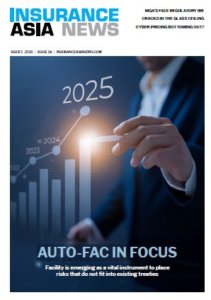Malaysian Re CEO Zainudin Ishak talks talent, ESG and flood risk
November 4 2021 by InsuranceAsia News
InsuranceAsia News (IAN) recently caught up with Zainudin Ishak, president and chief executive of Malaysian Re, as the reinsurer publishes its annual Asean Pulse report examining various industry trends across the region.
Highlights from this year’s report include the fact that their appears to be sufficient capacity in the market; the insurability of flood risk despite some inherent modelling difficulties; and the rising importance of ESG for insurers in terms of underwriting, asset management and operations.
IAN: According to Asean Insurance Pulse 2021, floods have caused over 45% of natural disaster losses since 1990 in the region and cost around US$137 billion. Did this result surprise you?
Ishak: From a Malaysian reinsurer’s perspective, the country is blessed to have the geographical location that is relatively sheltered from perils originating from tectonics movements, and located just outside path of major typhoons. Hence, the country’s natural catastrophes have been primarily floods, especially during the monsoon seasons. As a reinsurer with significant business generated from within Asean region, Malaysian Re was affected by the major floods which have affected the region over the last 10 years, such as the Thailand floods in 2011 and major Jakarta floods in 2013 and 2020, and thus we were motivated to commence the survey. Still, the results from the survey took us by some surprise as it reveals the true extent of economical and insured losses from the floods. We are glad to bring the issue to light for the Asean market.
IAN: What do you think are some of the most urgent ESG areas that Asean’s insurers should be addressing?
Ishak: One key finding from Asean Pulse 2021 is that the share of uninsured losses of total economic losses continues to exceed 90% for storms, floods and other natural catastrophes in Asean countries. We have seen actual evidence of man-driven climate change as 2016 was the warmest year on record with 2020 being the second, and warmer climates will increase atmospheric precipitation and result in stronger and more frequent rains and wind-related disasters. This suggests that the economic losses from natural catastrophes will continue to climb, and the protection gap will continue to widen.
Asean insurers have an important role to play as an increasing number of insurers have now sophisticated natural catastrophe models which can accurately assess the risks. And this information should be shared with the respective country’s authorities so appropriate disaster planning and management can be better aligned with financial risk management — an expertise that resides with insurers.
IAN: As we approach 2022, what are going to be the key priorities for Asean’s insurers over the next 18 months?
Ishak: Restoration of earnings will definitely be a key priority as many insurers have been negatively impacted from the deteriorated investment incomes over the last two years. Whilst the insurers’ toplines have been relatively stable, and the underwriting profits have marginally improved from lower claims from the motor class — which forms the bulk of most Asean insurers’ books — these have not been able to compensate for the loss of investment income. Many insurers in the region are indirectly owned by governments as majority shareholders, and they will require a boost of revenue collection to strengthen the social financial nets which have been stretched during the pandemic. However, dividend payments should also be balanced with the prudent act of strengthening one’s capital position.
Talent retention will also be a key priority as when the economy and borders re-open, staff who have patiently stayed with a company during the pandemic may find themselves sought after by other market players — both domestic and international. High-skilled talent may also find themselves accustomed to the new norms of flexible hours and work locations, so managing their expectations when businesses fully re-open again will be crucial so as not to lose them to insurers or industries that are more attuned to this flexibility.
Imprinting the hard lessons learned during the pandemic, such as the importance of fundamentals such as pricing discipline, prudent risk selection and cost-containment, should also be a priority as it will be tempting to revert to the pre-pandemic practice of foregoing those at the expense of growth. However, this should not hinder insurers from continuing to innovate and embracing the changes and opportunities that will arise post-pandemic.
-
Q&A: Global warming is creating uncertainty in valuation of physical assets
- September 26
Chelsea Jiang, Axa’s chief technical and innovation officer, general insurance for Greater China, shares her views on parametric, how companies can guard against convective storms, and HK’s role in narrowing China’s protection gap.
-
Q&A: Gallagher Re’s Mark Morley on renewals, inflation and pricing
- November 3
The Singapore-based APAC managing director shares his views.
-
Q&A: Swiss Re’s Mark Senkevics
- April 6
Head of P&C underwriting for Asia and ANZ on extreme flooding events in Asia, and how these can be managed going forwards.
-
Q&A: Hong Kong CIB’s chairman Alex Yip
- February 17
The broking association is prioritising professionalism and communication.
-
Allianz General | Allianz General combines innovative protection solutions while powering social good to lead Malaysian market
The insurer proactively addresses emerging risks and evolving customer protection needs while giving back to the community.
-
Sedgwick | Asia’s Energy Transformation – Balancing Growth, Risk and Renewables
Energy market presents unique risks, especially in a region which includes China and Japan as well as developing nations like Vietnam and the Philippines.
-
Beazley | Turbulent Waters: the maritime energy transition challenge
Businesses are facing a complex transition to non-carbon energy sources amid a push to achieve net-zero emissions for the marine sector by 2050.
-
Aon | Navigating shifts in the global and Asia insurance markets
Neelay Patel, Aon head of growth for Asia, says the market in Asia is at an ‘interesting stage of the cycle’.

